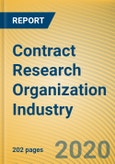The contract research organization (CRO) industry has been galloping amid the global pharmaceutical market steadily in headway, the vibrant financing in the medical and health sector, and the proliferating expenses for pharmaceutical R&D. In 2020, the world CRO market is expected to be worth $69.9 billion with a year-on-year spike of 9%.
Competition pricks up among at least 1,100 CRO players worldwide led by LabCorp, IQVIA, Syneos, Parexel, PRA, PPD, and Charles River. In 2019, IQVIA, LabCorp and Syneos were the three leaders sweeping a combined market share of 21.5%.
China’s great competitive edge over the developed countries in pharmaceutical R&D cost has allured many world-renowned pharmaceutical corporations and boosted the country’s CRO industry. With speedy development over a decade, China has been an important CRO market whose market size in 2020 will soar 10.1% on an annualized basis and reach RMB81.6 billion.
In addition to multinational giants represented by IQVIA, LabCorp, Parexel, etc., China also sees local CRO leaders including Wuxi AppTec, Pharmaron, Meidicilon, Shanghai ChemPartner, Tigermed, and Joinn Laboratories, where Wuxi AppTec with the strongest R&D strength as one of the most comprehensive service platforms integrating discovery, research and development of small-molecule chemical drugs, not only runs the China’s largest small-molecule pharmaceutical R&D service business but leads the way in global market. It enjoyed a virtually 12.3% (up 1.8 percentage points over the prior year) of the world’s CRO market in 2019.
China’s CRO industry will be heading towards:
- Mergers and acquisitions will still prevail for an industry reshuffle: Seen from the development course of multinational CRO companies, giants expand their business and sharpen edges through M&As, so do the Chinese CRO peers in recent year. In September 2020, Asymchem acquired the CRO company GoalGen for RMB30 million.
- Chinese CRO companies have landed in the capital market: WuXi AppTec and Pharmaron were listed on the A-share and H-share markets successively. In 2019, Viva Biotech went public on the Hong Kong Stock Exchange. In 2020, HitGen was listed on the A-share market.
- The industry gears toward vertical integration: Wuxi AppTec, for example, is able to provide customers with integrated new drug R&D and production services, which can help customers save plenty of time and costs as well as improve R&D and production efficiency. Noticeably, the players like Pharmaron, Boji Medical Biotechnological, Porton Pharma Solutions, and Shanghai ChemPartner are expanding to CMO/CDMO.
China Contract Research Organization (CRO) Industry Report, 2020-2026 highlights:
- Global CRO industry (development history/environment, market size, competitive landscape, etc.)
- China CRO industry (development environment, status quo, market size, competition pattern, development trends, etc.)
- 13 Chinese and 8 foreign companies (revenue, business structure, CRO business, etc.)
This product will be delivered within 3-5 business days.
Table of Contents
Companies Mentioned
- Wuxi AppTec
- Hangzhou Tigermed
- Guangzhou Boji Pharmaceutical
- Shanghai Meidicilon Inc.
- Porton Fine Chemicals
- Joinn Laboratories
- Pharmaron
- Obio Technology (Shanghai)
- Nanjing Huawe Medicine Technology Group Co., Ltd.
- Shanghai ChemPartner
- HitGen Inc.
- BioDuro
- VIVA Biotech
- LabCorp
- IQVIA
- Parexel
- Charles River
- PPD
- Syneos Health
- PRA
- ICON
Methodology

LOADING...








